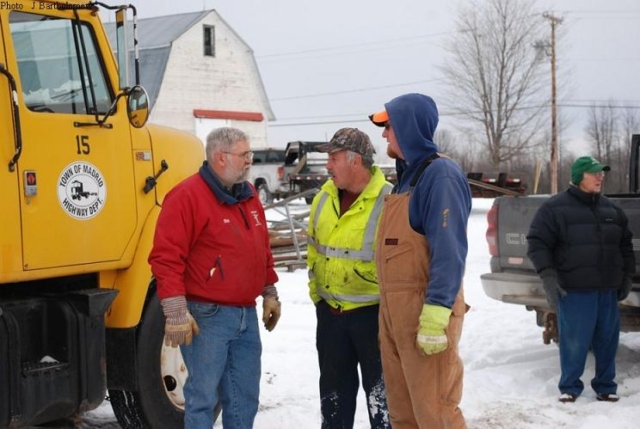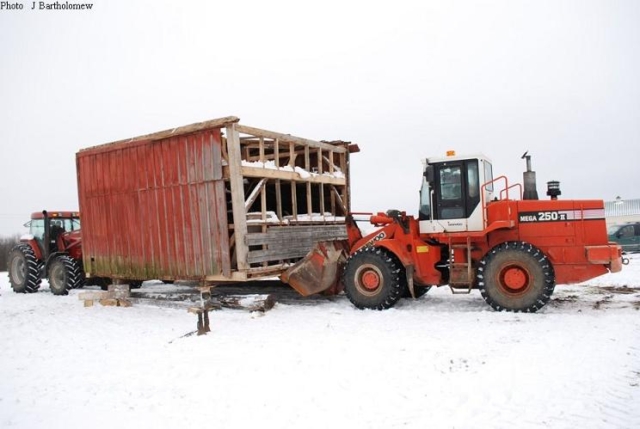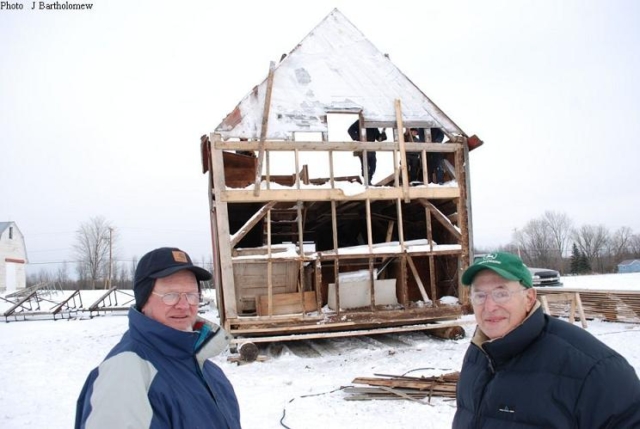SLPEM Welcomes The Walker Granary
By Roger Austin. From the Nov – Dec 2010 newsletter
 The classic 1½ story granary building from the former Walker farm near Madrid is about to be moved to the Museum grounds. Acquisition of the building had been made possible a few years ago by an anonymous donor. The relocation awaited completion of the new bridge before plans for the move was made. The project is being undertaken by Reg Chester, Gary Bush, Bob Moulton, Wayne Day, and John Castle. Working with them has been a skilled crew of Amish builders. They installed a new front sill and replaced a post and a beam on the back side. To accommodate road travel, the roof was dismantled and the gable ends lowered. The Town of Madrid has provided a flatbed truck . Once it arrives at the Museum, the granary will be set on blocks, reassembled, and covered with a new steel roof. Measures will be taken to weatherproof the building – as much as a granary can be. The building will be part of a future period farmstead and will be placed at its final site in 2011. The building was originally constructed by a skilled carpenter. The outer walls slant outward toward the top, a design used to discourage vermin from climbing. Boards and battens clad the outer walls on three sides. The fourth wall is cribbed with a double layer to simulate the appearance of the other walls. Each batten has chamfered edges. The first floor provides an open workspace. The upper level has bins for grain storage.
The classic 1½ story granary building from the former Walker farm near Madrid is about to be moved to the Museum grounds. Acquisition of the building had been made possible a few years ago by an anonymous donor. The relocation awaited completion of the new bridge before plans for the move was made. The project is being undertaken by Reg Chester, Gary Bush, Bob Moulton, Wayne Day, and John Castle. Working with them has been a skilled crew of Amish builders. They installed a new front sill and replaced a post and a beam on the back side. To accommodate road travel, the roof was dismantled and the gable ends lowered. The Town of Madrid has provided a flatbed truck . Once it arrives at the Museum, the granary will be set on blocks, reassembled, and covered with a new steel roof. Measures will be taken to weatherproof the building – as much as a granary can be. The building will be part of a future period farmstead and will be placed at its final site in 2011. The building was originally constructed by a skilled carpenter. The outer walls slant outward toward the top, a design used to discourage vermin from climbing. Boards and battens clad the outer walls on three sides. The fourth wall is cribbed with a double layer to simulate the appearance of the other walls. Each batten has chamfered edges. The first floor provides an open workspace. The upper level has bins for grain storage.
The Historical Timeline of The Walker Farm Granary
Grace Hargrave – December 2010
John Hall purchased 50 acres of land from Thomas Ogden on May 11, 1831. On October 28, 1837, he purchased 49 acres from Thomas L. Ogden. The last of three parcels was 49.87 acres purchased on April 30, 1847, from the estate of Joshua Waddington that would comprise the 150-acre farm now known as the Thomas Walker farm.
Charles Wheater purchased the land in 1918 from Edith Hall, partner of Tenant and Hall Grist Mill, formerly on the left at the village side of the Grass River bridge.
January 1, 1920, Thomas Walker, his wife Jennie, son Lloyd and daughter Irene moved from the Walker home (now Keith Caswells) to the Hall farm.
The granary was formerly situated on the house side of the road back of where the garage now stands. At some point, it was moved across the road to the location next to the main barn.
In the fall- the threshing crew came and threshed out the oats. The threshing machine was set up so the straw was blown up into straw mow of the barn. The oats were collected in bags – then carried by hand into the granary and dumped into bins that lined on side of building or bags of grain were carried upstairs and dumped in bins up there. I can remember split cedar rails being stuck in bins to help draw moisture out.
Lloyd married Mary Fields and came to live with his parents. Two children were born to Lloyd and Mary – Grace Walker Hargrave and George Walker.
Mary died in 1953 and Lloyd married Laura Partridge Fields in 1955. Lloyd and George moved to Lisbon at that time. They continued to farm until the mid-1960’s when there was an auction and farm machinery and tools were sold.
Jennie died October 14, 1972, followed by Tommie on October 28, 1972, on what would have been their 69th wedding anniversary.
Irene had been caring taker for her parents in their declining years. She continued to live in the house until August 2003 when she entered a nursing home. Irene died December 22, 2003, at the age of 94.
Jim and Grace Hargrave had purchased Lloyd’s share of the farm after Tommie and Jennie died and had cropped it several years. Upon Irene’s death, the rest of the farm and the house became theirs.
In February 2006, they deeded the house to the Madrid Historical Society, now known as the Walker House Museum.





















